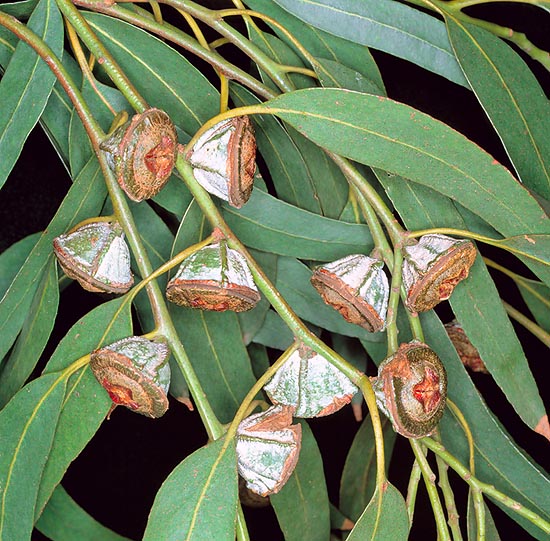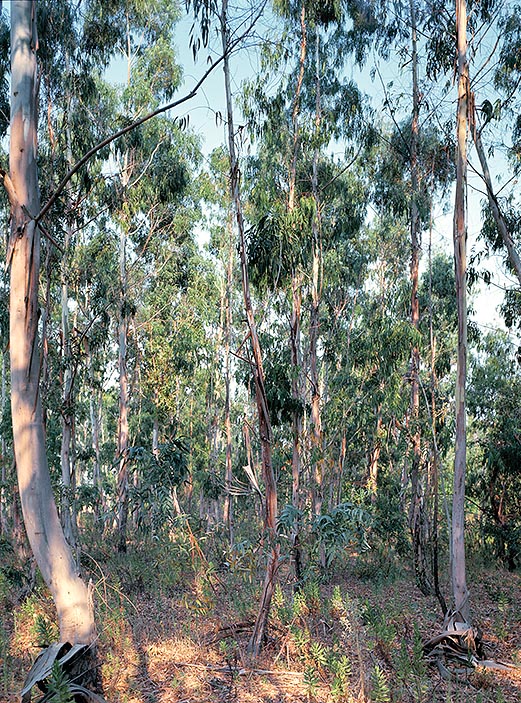Family : Myrtaceae

Text © Pietro Puccio

English translation by Mario Beltramini

Eucalyptus globulus fruits. The adult plants leaves have petioles © Giuseppe Mazza
The name of the genus is the combination of the Greek prefix “eu”= well and “kaliptos” = covering cap, with reference to the buds which have sepals and petals merged together forming a sort of hood (operculum) which falls down when the flower is ripe; the name of the species is the Latin term “globulus” = small sphere, button, with reference to the shape of the fruits.
Common names: bastard eurabbie, blue gum, common eucalyptus, eurabbie, fever tree, Gippsland blue gum, Maiden’s gum, southern blue gum, Tasmanian blue gum, Victorian blue gum, Victorian eurabbie (English); arbre à fièvre, eucalyptus globuleux, gommier bleu (French); eucalipto (Italian); eucalipto-comun, gomeiro-azul (Portuguese); eucalipto azul (Spanish); mkaratusi (Swahili); Blaugummibaum, Fieberbaum (German).
The Eucalyptus globulus Labill. (1800) is an evergreen, up to about 70 m tall, tree, even if in the wild there are taller specimens, with erect, cylindrical trunk with a diameter of even 2 metres.
In the adult plants, the bark at the base of the trunk is wrinkled, dark and persistent, upwards it is smooth, greyish and peels off in long strips which discover the underside with shades of different colour, grey, cream and bluish; the young branches are pendulous and have a quadrangular section in their terminal part.
The leaves in the young specimens and in the buds at the base of the trunk are sessile (without petiole), opposite, oblong with sharp apex, 10-15 cm long and 5-10 cm broad, of bluish green colour and waxy; the adult leaves, on 1-4 cm long petioles, are alternate, hanging, lanceolate or falcate, 10-30 cm long and 3-5 cm broad, coriaceous, of glossy dark green colour, aromatic due to the presence of several oleiferous glands.
The axillar flowers are hermaphrodite, solitary, rarely in clusters of 2-7 units, on a short peduncle, the buds are glaucous with sepals and petals merged together forming a sort of a hood (operculum) which falls down when the flower is ripe freeing a multitude of white or cream and 8-15 mm long, stamens; the pollination is done by nectarivorous birds and by insects.

It can be 70 m tall and is often cultivated for the wood and the essential oil © G. Mazza
It reproduces by seed, placed in surface on a sandy soil, which germinates in 1-2 weeks at the temperature of 20-22 °C, with the first flowering taking place usually when 4-5 years old; it can reproduce also by air layering.
The seedlings develop at the base a woody underground structure having functions of reserve, called lignotuber, endowed of several dormant buds from which new plants may regenerate in case of destruction, for various causes, up to the ground level, of the previous one.
It is the most cultivated species of the genus, in Australia as well as elsewhere in the world, in the Mediterranean climate areas, subtropical and warm temperate with rainy winters and warm and dry summers.
During the first years of life, the growth is particularly fast, as it may exceed even the 2,5 m per year.
It grows up in various types of soil, even poor, provided it is not too much calcareous, but with preference for the deep, loose, draining, acidic or neutral, soils; the best exposition is in full sun and for what the resistance to the low temperatures, the juvenile plants are rather sensitive, the death of the plant may occur already by around the -5 °C; the resistance increases with the age, up to about -8 °C, only if for very short periods.
While expanding, it tends to form monocultures for the presence in the leaves and in the fragments of bark, which decay very slowly, of substances which hinder the growth of other vegetation, as well as for the radical apparatus, expanded and “voracious”.
The species has been introduced, in the past, in many countries for reclaiming swampy and malarial zones, thanks to its high capacity of absorbing the water from the soil; presently, it is utilized, apart ornamental purposes, for creating windbreak and noise barriers and for controlling the erosion.
The Eucalyptus globulus is the main source of the essential of oil of eucalyptus, present in the leaves in percentages between the 1,5% and the 3,5%, formed mostly, the 70-85%, by cineol (eucalyptol), employed in the respiratory ailments. The essential oil is also used by the alimentary industry, as aromatizing agent, in various foods and drinks, and by the cosmetic one.
It is the floral emblem of Tasmania.
Synonyms: Eucalyptus pulverulenta Link (1822); Eucalyptus glauca A.Cunn. ex DC. (1828); Eucalyptus perfoliata Desf. (1829); Eucalyptus gigantea Dehnh (1832); Eucalyptus globulosus St.-Lag (1880).
→ To appreciate the biodiversity within MYRTACEAE family please click here.
